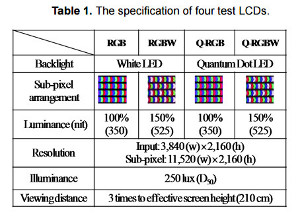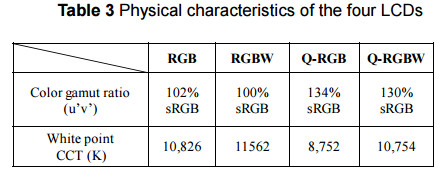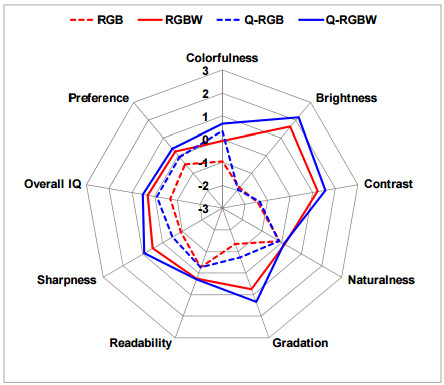One would think that the mixing of a white subpixel element in an RGBW LCD (or OLED) architecture might “pollute” the color gamut of the display leading to washed out color performance. However, we know that Samsung mobile OLED panels and LG signage panels (both with RGBW pixels) have excellent color performance. At SID, Taiwan Tech did a study to quantify what we have seen to better understand why there is no degradation in color performance.
In paper 17.4 (Image Quality Assessment of Large UHD LCDs using Quantum Dot and RGBW Technologies), the speaker noted that part of the motivation for adding a white sub-pixel is to allow a brighter display for the same power consumption, or maintain the brightness and reduce the power consumption. Sometimes, the resolution will also be reduced unless sub-pixel rendering algorithms are applied as well.
In the paper, the authors evaluated four displays. These include RGB and RGBW pixel architectures with and without a film-type quantum dot color gamut expanding technology (Q-RGB and Q-RGBW). Two experiments were done that included evaluation of the image quality of 14 test images and then the evaluation of image quality with natural images in 7 tone areas. Tables 1 and 3 from the paper shows the characteristics of the four displays.


The results are shown in the figure below. As can be seen, the quantum dot technology is the same or better in every category compared to the non-QD version. In addition, the RGBW version is judged the same or better in nearly every category except colorfulness. Here, the quantum dot RGB was judged slightly better than the RGBW display without QD.
Perhaps surprisingly, the RGBW displays also out performed RGB in contrast, gradation, readability, sharpness and overall image quality. Since they are also brighter, it may be that this higher brightness range is more optimal for perceiving these qualities.

The authors concluded that the new sub-pixel rendering and color recovery algorithms are indeed working very well now and offer superior performance.

